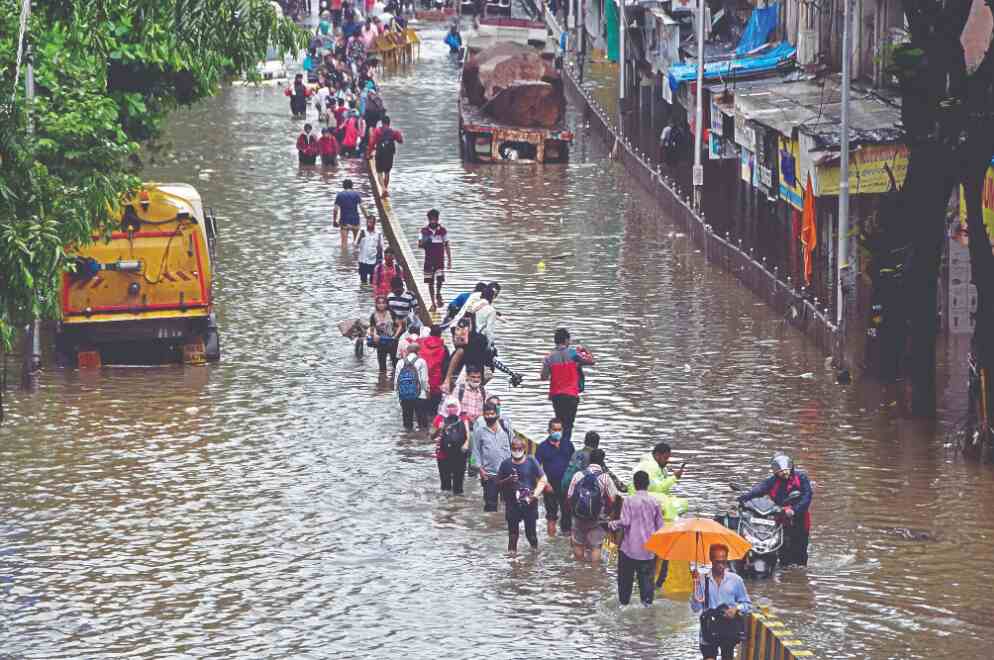Rain fury claims 30 lives in Mumbai

Mumbai: Thirty people died in rain-related incidents as incessant heavy downpour overnight during a major thunderstorm pummelled Mumbai, causing severe water logging and traffic disruptions in the financial capital on Sunday.
The Western Railway and Central Railway briefly suspended suburban train services in Mumbai after the heavy rains, and many long distance trains were terminated or regulated at various stations, officials said.
Nineteen people died as a compound wall came crashing down on some houses located on a hillock after a landslide, a fire official said.
The retaining wall of the Bharatnagar locality in Mumbai's Mahul area collapsed at 1 am, the official said. Seven people were injured and taken to nearby Rajawadi hospital, he added.
A civic activist said this is among the 257 hutments that have come up on hillocks in the city. In the last 29 years, 290 people in such localities have been killed in landslides and collapses during monsoon, he added.
Ten hutment dwellers died as six shanties collapsed after a landslide in Mumbai's Vikhroli suburb at 2.30 am, a civic official said. Two persons were injured and were sent to a nearby hospital, he added.
A 16-year-old boy died after a forest department compound wall collapsed in suburban Bhandup, an official said. Mumbai recorded over 250 mm of rain in just three hours (between midnight and 3 am), touching 305 mm by 7 am on Sunday, a meteorologist said.
The India Meteorological Department (IMD) said Mumbai was placed under a red alert, indicating heavy to very heavy rainfall with extremely heavy rainfall at isolated locations for the rest of the day.
Images from a doppler radar showed that the thunderstorm had a cloud top height of nearly 18 km (around 60,000 feet), the IMD said.
To put in other words, the height/vertical extent of this monster thunderstorm is approximately twice that of Mount Everest!, tweeted meteorologist Akshay Deoras. Such thunderstorms are definitely uncommon for Mumbai or the west coast during an active phase of the monsoon and in a month like July. The cloud top height of this monster thunderstorm is definitely comparable to the one that produced rains on 26 July 2005, he said.
Thunderstorms have already been observed on the following five days in this month: On July 9, 11, 12, 16 and 17, said Deoras, a PhD student in the Department of Meteorology at the University of Reading in the United Kingdom.
Meanwhile, the heavy overnight rains led to Vihar Lake overflowing on Sunday morning, a civic official said.
A BMC statement said the lake, with a storage capacity of 27,698 million litres, is the smallest of the water bodies that are part of the supply mechanism to the metropolis.
Built in 1859, the lake supplies 90 million litres water per day, the civic body said.
Prime Minister Narendra Modi expressed anguish at the loss of lives caused by wall collapse incidents in Mumbai.
His office also announced Rs 2 lakh each for the next of kin of the deceased from the Prime Minister's National Relief Fund. A sum of Rs 50,000 would be given to the injured.
"Saddened by the loss of lives due to wall collapses in Chembur and Vikhroli in Mumbai. In this hour of grief, my thoughts are with the bereaved families. Praying that those who are injured have a speedy recovery," Modi said
President Ram Nath Kovind also expressed grief over the rain-related deaths in Mumbai. Maharashtra Chief Minister Uddhav Thackeray expressed grief over the loss of lives and announced an ex-gratia of Rs 5 lakh for the kin of each of the victims.



